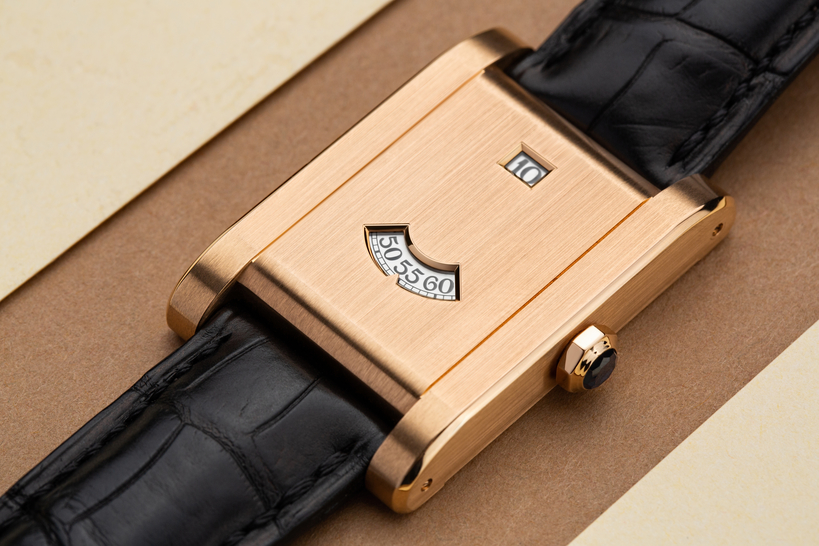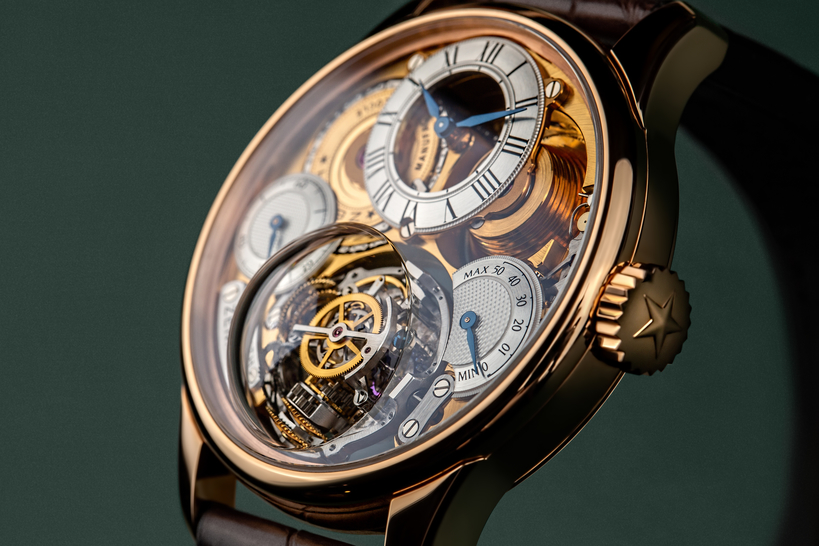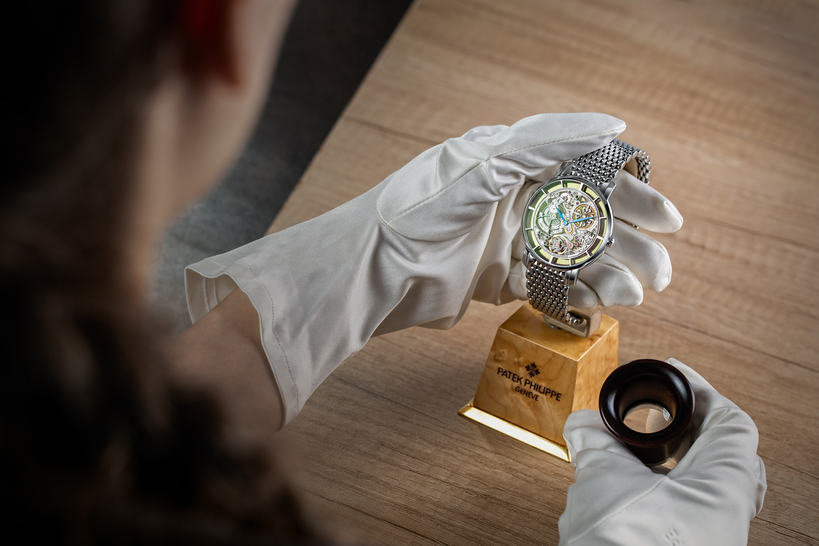There were 21 prizes awarded at the 22nd awards ceremony of the Grand Prix d’Horlogerie de Genève (GPHG): 20 for timepieces and one for a person.
The “best-in-show” Aiguille d'Or prize was very deservedly awarded to Maximilian Büsser's stunning LM Sequential EVO chronograph. It represents more than just two chronographs in one case — it's a new extremely progressive direction for the development of wristwatch timers. Both chronograph modules have their own counters for 30 minutes and 60 seconds.
Both chronograph modules have their own counters for 30 minutes and 60 seconds. They can time intervals separately or simultaneously. But this watch has much more to offer.
The revolutionary Twinverter binary switch allows the watch to function in split-chronograph mode or even as a chess clock, where each player has a strictly limited total time to plan their moves, and while the player taking their turn is deliberating, the other player's clock is stopped.
The price for this masterpiece is CHF 172,000. And didn't Maximilian Büsser have another wonderful idea to create an affordable watch for members of his fan club? The M.A.D.1 Red was born as a result, housing a modified and inverted democratically priced self-winding Japanese Miyota movement, costing just CHF 3,125.
Büsser only had to announce orders were being taken for over 20,000 people to register for the model within a couple of days. Not only was this watch the object of desire for all collectors, ordinary people wanted to get one as well.
The watch had to be raffled off. The situation is actually very reminiscent of the Swatch x Omega Speedmaster MoonSwatch collaboration. It's anyone's guess who this year's Challenge Watch Prize would have gone to if Swatch Group brands had taken part in the contest.
Apart from the two watches by Büsser, we reckon there are at least another seven prizewinning models from the GPHG 2022 that would enrich any collection. The work of Albanian watchmaker Rexhep Rexhepi, Akrivia Chronomètre Contemporain II (CHF 125,000).
The beautiful wristwatch marine chronometer Ferdinand Berthoud FB 2RSM.2-1 (CHF 270 000); a stunning chronograph almost completely created and decorated by hand, Grönefeld 1941 Grönograaf Tantalum (CHF 180,500).
Of course, the unique Ji-Ku watch by Kari Voutilainen with a dial decorated using Saiei Maki-e and Somata Zaiku lacquering techniques (CHF 365,000); the unique Van Cleef & Arpels Fontaine Aux Oiseaux automaton interior clock (priced from CHF 5,000,000 to 10,000,000).
And the flawless, fully hand-decorated debut work by the young watchmaker Sylvain Pinaud — Origine (CHF 73,200). The prizewinner who probably deserves to be discussed above all is François Junod. The winner of the Special Jury Prize still lives in the tiny Swiss village of Sainte-Croix near Neuchâtel where he was born.
He's the only contemporary master who makes original automata for wristwatches. His choice of profession was influenced by more than just being particularly drawn to mechanics and working in peace and quiet, surrounded by beautiful mountain scenery.
Rather than a tradition of watchmaking, inhabitants of Sainte-Croix and neighboring L'Auberson happen to have a long history of making automata and music boxes. In books from the 19th century, these little villages are described as the largest manufacturing hubs for various types of mechanical automata.
The rather fascinating Museum CIMA (Centre International de la Mécanique d'Art) in Sainte-Croix, specializing in musical boxes and automatons, still welcomes visitors to this day. François Junod had made a couple of playful moving figurines for large striking clocks, but his wristwatch automata were a chance creation.
He was set on this path by the famous independent watchmaker Vianney Halter, known as the creator of the Harry Winston Opus 3, the Cabestan chain-driven concept watch and other marvelous models.
A not so well-off yet very proud Vianney Halter happened to rent premises close to Junod's house for work and accommodation — remote, on ountainous terrain, but affordable. Junod initially completed orders for Ulysse Nardin: battling Mongolian warrior figurines for the famous "Genghis Khan" Westminster carillon minute repeater jacquemart tourbillon, and the moving animals on the dial of the "Jungle" model are also his work.
He was then enlisted to help revive the company Reuge Music, which specializes in manufacturing music boxes and pocket watches with automata. Junod has even created a poet-automaton mechanism called "Pushkin", although the original name "Pushin Android" is a more accurate description of what the creation essentially is.
A machine that bears a resemblance to the great Russian poet, if only for its curly head of hair and sideburns, sits at a desk and pens 24 words he knows in English in a completely random combination. The number of possible word combinations is 1458.
Some find the Pushkin Android's "revelations" profound. Each haiku-like poem by the mechanical android is accompanied by one of six famous Pushkin drawings taken from his original manuscripts, and the "poem" is signed with an autograph or initials. Junod’s Pushkin earned him the Workmanship and Design nomination at the prestigious Gaia Awards in 2011.
Yet the pinnacle of Junod's creative work has to be the highly complicated wristwatch model Daniel Roth il Giocatore Veneziano (It. "the Venetian Player"). Junod added a fully independent module in the shape of a dice player to the famous DR 7300 minute-, hour- and quarter-striking repeater movement with cathedral gong.
The dice player's look is inspired by none other than Caravaggio's "Cardsharps". If you press the pusher on the side at 2 o'clock, the candle on the table "ignites" for a couple of seconds and the dice player's hands begin turning the goblets with dice. You can see exactly how he's rolled the dice by pressing the pusher on the side at 4 o'clock.
He then lifts one of the goblets for a short while. The total number of possible combinations the dice player can throw is 72, which means there are 504 possible rolls of the dice. Experts were stunned by this model's complexity, sophistication and impeccable aesthetic beauty.
In 2012, François Junod introduced yet another masterpiece, where enamel art meets the arts of jewelry, watchmaking and sculpture. The model Jaquet Droz Bird Repeater is also a wristwatch minute repeater, complemented by another well-known traditional classic complication — a songbird.
The mechanism appears to have been borrowed from Daniel Roth, given that the Jaquet Droz RMA88 has similar specs to the movement used in "il Giocatore Veneziano": a frequency of 18,000 vph, hour and minute display, hand winding and a single barrel with a 48-hour power reserve.
The mother-of-pearl dial with a black onyx center is engraved and painted by hand, as are the bird figurines. The Jaquet Droz Bird Repeater was released as a Numerus Clausus edition in a 47-mm red-gold case, limited to eight pieces.
It's worrying that there's almost no one around to follow Junod. The well-known watchmaker Svend Andersen has experimented with the fairly obscene models Eros 69 and Bill & Monica, which illustrates a famous scene from the Oval Office involving the former US president and a female White House intern.
But can we call these experiments automata? Technically, within a broad definition, they are. But the Danish watchmaker recently marked his 80th birthday, so it's Junod who probably should be referred to as Andersen's successor, not the other way around.
Overall, it's a shame François Junod rarely allows himself to be distracted by orders from watchmakers. As a true automaton maker, he prefers working with more monumental dimensions. Yet he has watchmakers to thank for being able to expand production and hire five employees: a sculptor, carpenter, a couple of mechanics and a tailor. We can only hope the ingenious master will soon take some apprentices under his wing.



